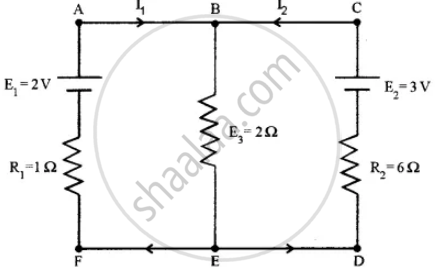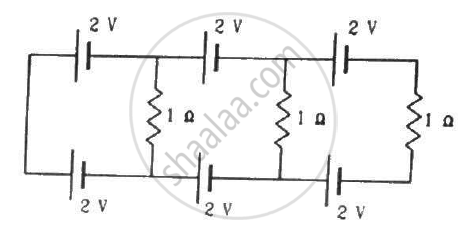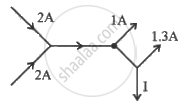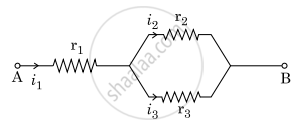Advertisements
Advertisements
Question
In the circuit shown in the figure below, E1 and E2 are two cells having emfs 2 V and 3 V respectively, and negligible internal resistance. Applying Kirchhoff’s laws of electrical networks, find the values of currents l1 and I2.

Solution
The distribution of current in the circuit is as shown in figure

Applying Kirchoff's laws (Loop law) to loop ABEFA
-2 (I1 + I2) - I1 × 1 + 2 = 0
2 - I1 - 2(I1 + I2) = 0
⇒ 2 - 3I1 - 2I2 = 0 .....(i)
Applying to loop BCDEB
-3 + 6I2 + 2(I1 + I2) = 0
⇒ 3 - 6I2 - 2I1 - 2I2 = 0
⇒ 3 - 8I2 - 2I1 = 0 ....(ii)
Solving equations (i) and (ii), we can write
I1 = `1/2`A , I2 = `1/4` A
APPEARS IN
RELATED QUESTIONS
Determine the current in each branch of the network shown in figure.

Given n resistors each of resistance R, how will you combine them to get the (i) maximum (ii) minimum effective resistance? What is the ratio of the maximum to minimum resistance?
Determine the equivalent resistance of networks shown in Fig.

Find the circuit in the three resistors shown in the figure.

Solve the following question.
Using Kirchhoff’s rules, calculate the current through the 40 Ω and 20 Ω resistors in the following circuit.

A copper wire of 10-6 m2 area of cross-section, carries a current of 2 A. If the number of electrons per cubic meter is 8 × 1028, calculate the current density and average drift velocity.
Kirchhoff’s second law is a consequence of law of conservation of ______.
The figure below shows current in a part of electric circuit. The current I is ______.

Three resistors having resistances r1, r2 and r3 are connected as shown in the given circuit. The ratio `"i"_3/"i"_1` of currents in terms of resistances used in the circuit is :

What is the advantage of using thick metallic strips to join wires in a potentiometer?
